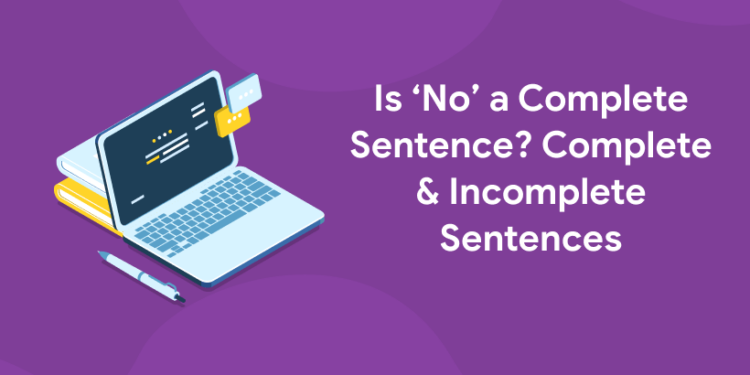Table of Contents
To communicate effectively, it is necessary to write sentences in the correct format. You must learn to distinguish a complete sentence from an incomplete one if you want your words to make perfect sense to your readers and listeners. It’s easy to understand the distinction between complete and incomplete sentences. These sentences contain specific properties that tell them apart from one another, aside from the proper usage of punctuation marks. We must first define the two to gain a better understanding of the subject.
Click here to get and practise more examples of complete sentences
What is a Sentence?
A sentence is the most complex autonomous unit of grammar. It starts with a capital letter and finishes with a period, question mark, or exclamation point. A word or combination of words that represents a complete idea and includes a subject and a verb is typically (and imperfectly) defined as a sentence.
What are the Types of Sentences?
1: Which of the sentences below is grammatically correct?
The following are the four basic sentence structures:
- A simple sentence contains only one independent clause.
- Compound sentences are made up of two (or more) simple sentences connected by a conjunction or a punctuation mark.
- A complex sentence is a sentence with at least one dependent clause and an independent clause (or main clause).
- A sentence comprising two or more independent clauses and at least one dependent clause is called a compound-complex sentence.
Click here to get notes about how to distinguish between types of complete sentences
What is a Complete Sentence?
Most, if not all, of the following traits, can be found in a complete sentence:
- It has a capital letter at the beginning.
- A subject and a predicate are required (verb).
- It needs to express a complete idea.
- It comes to a close with a period (.), a question mark (?), or an exclamation point (!).
A complete sentence must have a subject that tells us “who” or “what” is being discussed, as well as a predicate that describes the subject’s behaviour. Compliments, which are words that accompany the verb, may be included in the predicate. Another thing to look for is whether or not the sentence represents a complete idea. If you’re left hanging or feel like something is missing, it’s most likely an incomplete sentence. There are times, however, when a statement begins with a capital letter and finishes with a punctuation mark, yet it is not regarded as a complete sentence. This is due to the possibility that the main clause is absent. The independent subject and verb are both present in the main clause of the sentence. If either of these elements is missing, you may have produced a fragment rather than a complete sentence.
Register to improve spoken English skills by learning grammar
Types of Complete Sentences
The types of complete sentences and examples are provided below.
Declarative Sentence
Declarative sentences are simply statements that convey information. These assertions might be simple or compound sentences with a full stop at the end. However, because these are the most prevalent sort of sentences in the English language, it is simple to recognise them as complete sentences. Although declarative sentences are usually complete sentences, not all complete sentences are declarative sentences.
Example: I took a bus here.
Grab the latest notes on types of complete sentences
Interrogative Sentence
Interrogative sentences are written in the form of a question, with a question mark at the ending. You may have difficulties locating its subject because it can come between sections of the verb phrase or straight after the verb.
Example: What would you like to eat?
Exclamatory Sentence
This is a stronger and more expressive variant of a declarative sentence. An exclamatory statement expresses the speaker’s desire to convey a sense of enthusiasm or intensity. Instead of a period, an exclamation is added to the end of the phrase to correctly portray one’s emotional reaction.
Example: I can’t believe this!
Imperative Sentence
In form, an imperative sentence resembles a declarative statement, but it can be distinguished by the meaning it conveys. Imperative statements, which include requests and demands, are often the exception. Even if the subject isn’t stated explicitly in the sentence, it is implied. Even something as basic as “Come” could be deemed a complete phrase.
Example: Shut up.
Click here to view more examples of imperative sentences
What is an Incomplete Sentence?
Even in this day and age, an incomplete sentence, also known as a sentence fragment, is a prevalent error. While they may be acceptable in spoken English, they might lead to misunderstanding and confusion when written.
Example:
incomplete sentence: Because it rained today.
Complete sentence: I was late to work because it rained today.
A conversation between two people is depicted in the following. You can respond to the given question in one of two ways: with a whole sentence or with a simple sentence fragment. The first response has a dependent clause rather than an independent clause, which is correct in spoken English but improper in written English. In the second line of the given example, an independent clause is added to deliver a clearer message.
Register to learn more about various kinds of clauses
Independent Clause
An independent clause is a set of words that may stand alone to deliver a clear statement. It usually consists of a subject, a verb, and a complete thought.
Example: I was late for the work
Dependent Clause
Dependent clauses, as you may have noticed, maybe a bit puzzling. It may have a subject and a verb, but it does not convey a complete meaning. Dependent markers come at the start of the clause and are frequently made up of subordinating conjunctions. After, although, as, as if, because, before, where, until, while, once, since, and rather than are only a few examples of subordinating conjunctions. When this occurs, it’s critical to join it to an independent clause to make a complete sentence.
Example: what he expected
Click here to attend practise questions from the chapter sentences and types of sentences
Is ‘No’ a Complete Sentence?
There are mixed opinions about this question. Some say that “no” is a word as well as a sentence. The words ‘yes’ and ‘no’ are interjections. The word ‘no’ can also be used as a determiner. Interjections work similarly to emojis. ‘Yes’ stands for ‘that is true,’ whereas ‘no’ stands for ‘that is not true.’ When a shortcut expresses everything a clause would express, the clause can be removed, leaving simply the shortcut. This is still a sentence since the clause is processed as if it were present.
On the other hand, a set of words must meet two characteristics in English grammar to be considered a sentence:
- There should be a subject and a finite verb in it.
- It should convey a comprehensive concept.
No is not a sentence in this context because it fails to meet the first criteria. And, similarly in the case of imperative sentences, if there were exceptions to the above two conditions, they would have been specified as well. Even though an imperative lacks a clear subject, it is nonetheless regarded as a sentence (examples: Go and Leave now). But there hasn’t been a single exception made for anything even close to No.
No is a sentence fragment, indicating that it is not a complete sentence. A sentence fragment is a group of words punctuated as if they were a sentence, but they aren’t. It is usually regarded as a mistake, particularly in professional writing, but when utilised correctly, it may be extremely effective. The use of a sentence fragment in response to a question – and No comes into this category – is usually successful, but it isn’t a sentence.
Click here to learn more about sentence fragments
Few words are deleted in elliptical phrases to avoid repetition from the previous sentence or clause.
Examples: I planned to buy a red-colour book but bought a black book. [Complete sentence]
I planned to buy the red-colour book but bought black. [Elliptical form of the sentence, with book omitted]
Even if only a few words are absent, elliptical forms are sentences. The words that are missing are implied. Returning to No, one argument in favour of it being a sentence is that it is an elliptical kind of sentence, and so is a sentence.
Example: Did you see my book? No, I didn’t see your book.
However, there is a flaw in this argument. The preceding sentence is not elliptical. Elliptical sentences are formed by deleting only the repeating elements of sentences, such as the noun, verb, or verb and its complement, rather than the complete sentence. As a result, No can be misconstrued as an elliptical sentence and so cannot be classified as a sentence. It’s a fragment. Fragments are elliptical as well, although not in the same way that elliptical sentences are. To summarise, Yes, No, and other similar expressions have been used as sentences so frequently that they are commonly mistaken for sentences. They aren’t, however. They are sentence fragments.
Enroll for Spoken English Course! Download Entri App!
As important as using complete sentences in writing is, expressing yourself in complete sentences through verbal communication is a fantastic way to improve your speaking fluency. What students learn in face-to-face interactions and conversations can subsequently be applied to their writing. While complete sentences may appear strange at first, there’s no doubting their value in creating coherent communication. Download Entri App to improve your grammar knowledge to enhance your speaking and writing skills.










